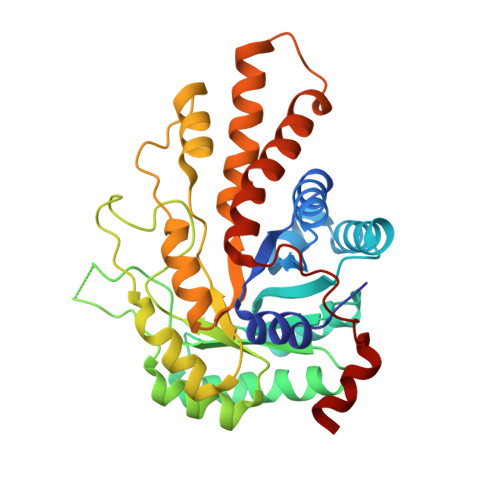Rational design, synthesis and evaluation of first generation inhibitors of the Giardia lamblia fructose-1,6-biphosphate aldolase.
Li, Z., Liu, Z., Cho, D.W., Zou, J., Gong, M., Breece, R.M., Galkin, A., Li, L., Zhao, H., Maestas, G.D., Tierney, D.L., Herzberg, O., Dunaway-Mariano, D., Mariano, P.S.(2010) J Inorg Biochem 105: 509-517
- PubMed: 21333622
- DOI: https://doi.org/10.1016/j.jinorgbio.2010.12.012
- Primary Citation of Related Structures:
3OHI - PubMed Abstract:
Inhibitors of the Giardia lamblia fructose 1,6-bisphosphate aldolase (GlFBPA), which transforms fructose 1,6-bisphosphate (FBP) to dihydroxyacetone phosphate and glyceraldehyde 3-phosphate, were designed based on 3-hydroxy-2-pyridone and 1,2-dihydroxypyridine scaffolds that position two negatively charged tetrahedral groups for interaction with substrate phosphate binding residues, a hydrogen bond donor to the catalytic Asp83, and a Zn(2+) binding group. The inhibition activities for the GlFBPA catalyzed reaction of FBP of the prepared alkyl phosphonate/phosphate substituted 3-hydroxy-2-pyridinones and a dihydroxypyridine were determined. The 3-hydroxy-2-pyridone inhibitor 8 was found to bind to GlFBPA with an affinity (K(i)=14μM) that is comparable to that of FBP (K(m)=2μM) or its inert analog TBP (K(i)=1μM). The X-ray structure of the GlFBPA-inhibitor 8 complex (2.3Å) shows that 8 binds to the active site in the manner predicted by in silico docking with the exception of coordination with Zn(2+). The observed distances and orientation of the pyridone ring O=C-C-OH relative to Zn(2+) are not consistent with a strong interaction. To determine if Zn(2+)coordination occurs in the GlFBPA-inhibitor 8 complex in solution, EXAFS spectra were measured. A four coordinate geometry comprised of the three enzyme histidine ligands and an oxygen atom from the pyridone ring O=C-C-OH was indicated. Analysis of the Zn(2+) coordination geometries in recently reported structures of class II FBPAs suggests that strong Zn(2+) coordination is reserved for the enediolate-like transition state, accounting for minimal contribution of Zn(2+) coordination to binding of 8 to GlFBPA.
- Department of Chemistry and Chemical Biology, University of New Mexico, Albuquerque, NM 87131, USA.
Organizational Affiliation:


















